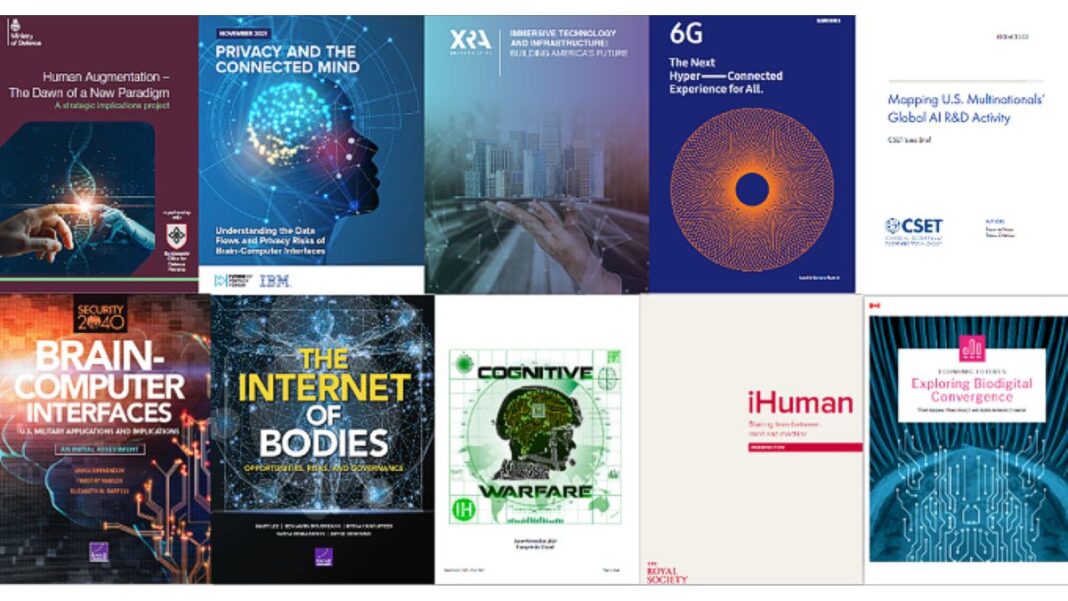Transhumanism editor Joe Allen lays out the Big Tech agenda for transforming humans into cyborgs.
“It’s not as fringe as many people think. Everyone from Klaus Schwab to Elon Musk to Mark Zuckerberg, these are incredibly powerful, incredibly influential people. … I guess that brings me to an article. The title is ‘Beyond the Great Reset: 10 Official Documents on Human-Machine Hybrids.’ This article is simply a summary of 10 different documents published between 2019 and 2021, and these are not papa]ers from obscure academics… These come from the UK Ministry of Defense, from Rand Corporation… one from NATO, and another comes from Samsung, so we’re talking about some of the top players, thinkers and influencers in not only the power structure of the government but particularly the military and also the corporate world…. The common element is the drive toward Humanity 2.0 by using brain-computer interfaces to merge the human mind to artificial intelligences.”
BEYOND THE GREAT RESET – 10 Official Documents On Human-Machine Hybrids
The Great Reset was a global initiation rite, drawing embodied souls into the digital realm. Shaken by the contagion, otherwise normal people recoiled from human contact and were forced to become transhuman screen-monkeys. As the New Normal intensified, this dependence became a feature, not a bug.
Despite the topic’s obvious relevance, most discussion of transhumanism remains on the fringe. When serious people do confront it in public, they tend to skirt the hard problems or simply mock the notion. Yet in these ten documents, published between 2019 and 2021, we see an open embrace of transhumanist ideas by military, government, and corporate analysts.
The concept of “transitional humans” hurtling toward a technological Singularity unfolds on three levels. The bedrock is biological life—our bodies and brains. Above that is cultural life, where embodied souls are guided by language, tools, and custom. In the 20th century, the emergence of artificial life—silicon-based digital beings—opened bizarre possibilities.
Presently, five vectors are rapidly converging on the transhuman ideal:
- Gene-editing (body)
- Neuroenhancement (brain)
- Bionics (cyborg culture)
- Robotics (digital body)
- Artificial Intelligence (digital brain)
The documents below chart that convergence, each from a different angle. One after another, they confront the total transformation of human beings through technology. Cyborgs are already among us, and commercial brain-computer interfaces (BCI) loom just over the horizon.
1 – UK Ministry of Defense — Human Augmentation (2021)
2 – IBM — Privacy and the Connected Mind (2021)
3 – XRA — Immersive Technology and Infrastructure (2021)
4 – Samsung — 6G: The Next Hyper-Connected Experience for All (2020)
5 – CSET — Mapping U.S. Multinationals’ Global AI R&D Activity (2020)
6 – RAND Corp. — The Internet of Bodies (2020)
7 – RAND Corp. — Brain-Computer Interfaces (2020)
8 – NATO — Cognitive Warfare (2020)
9 – The Royal Society — iHuman (2019)
10 – Policy Horizons Canada — Exploring Biodigital Convergence (2019)
If the eyes are windows to the soul, then electrodes snaking into gray matter will be thieves slipping in the backdoor. As you’ll see, that door is wide open.
1 – UK Ministry of Defense — Human Augmentation (2021)
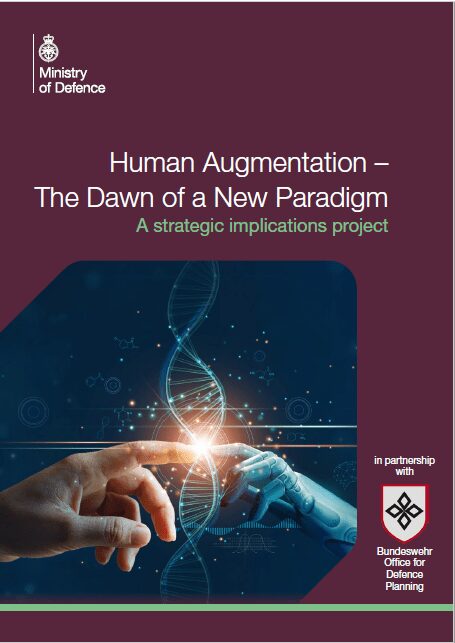
Transhumanist ambitions are made possible by military technology. In the 1960’s, the first serious efforts to create a brain-computer interface were funded by the U.S. Defence Advanced Research Projects Agency (DARPA). Two decades later, the Internet was developed to make communication lines redundant in case of nuclear war.
Human Augmentation: A New Paradigm, commissioned by the UK’s Ministry of Defense, follows various technological threads to their logical conclusions. A central goal is to merge minds with machines in an intimate human-AI symbiosis:
The ability to enhance one’s physical, psychological, or social capability has been a source of power throughout history, and warfare is the epitome of this dynamic. …
Human augmentation will become increasingly relevant, partly because it can directly enhance human capability and behavior, and partly because it is the binding agent between people and machines. Future wars will be won, not by those with the most advanced technology, but by those who can most effectively integrate the unique capabilities of both people and machines. …
Thinking of the person as a platform and understanding our people at an individual level is fundamental to successful human augmentation.
Beyond cyborg super soldiers, the principle of transcending human limitation through technology is also being applied to civilian populations. One critical concept is that standard tools and transformative technologies—from the abacus to smartphones to brain implants—exist on a spectrum.
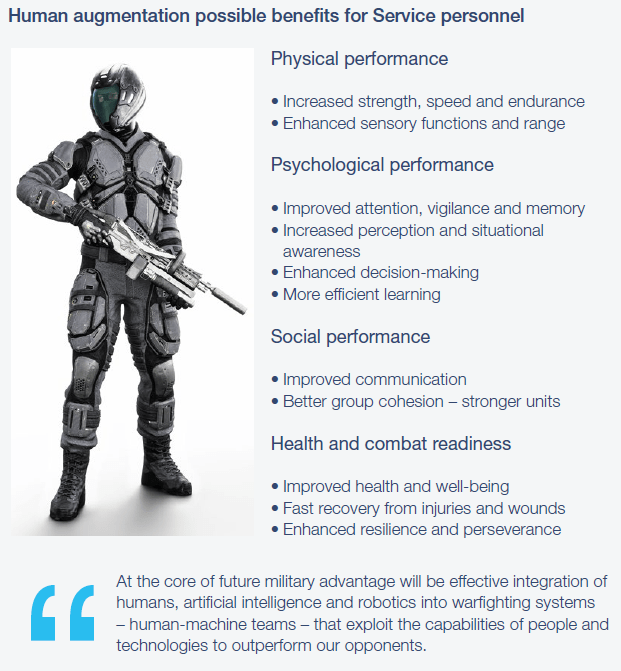
In the curiously prescient image below, we see a man using an implanted BCI to type “Hello world” onscreen. Keep in mind, this document was published in May of 2021.
Eight months later, an actual paralyzed man used his Stentrode implant—developed by Synchron—to send the first tweet using only the brain. His message?
In a follow-up tweet, the patient said:
“my hope is that I’m paving the way for people to tweet through thoughts”
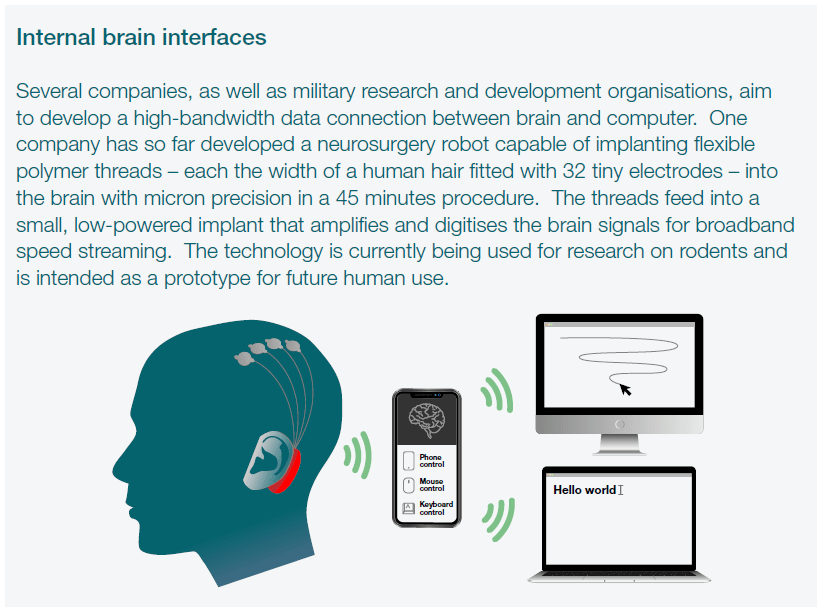
Imagine receiving neuroenhancement that could rid you of bigotry, or suspicion, or even your warped sense of humor. If “diversity is our strength,” then a polyglot, digitally enhanced superorganism will be unassailable:
Human augmentation could help improve social cohesion by increasing participation in society regardless of individual differences or impediments. Human augmentation could also allow people to connect in more intense and creative ways (for example, via linked brain-machine interfaces).
Human augmentation will also provide tools for people to express their individuality in more pronounced ways, potentially leading to a more diverse society.
Considering the rise of biosecurity states across the globe, an especially horrific aspect of Human Augmentation is the comparison of anti-cyborg sentiments to vaccine hesitancy:
The history of vaccinations demonstrates how proven, and seemingly uncontroversial human augmentation technologies can take many years to become globally effective and accepted by societies. … This example shows that we cannot assume human augmentation will be automatically effective or accepted in its intended use, no matter how beneficial its effects may be. … Human augmentation may be resisted by elements of society that do not trust the effectiveness and motive of augmentation.
Of course, no review of our cyborg future would be complete without indie biohacking. According to the implant company Dangerous Things, anywhere from 50,000 to 100,000 people already have digital bio-implants in their bodies.
Perhaps inspired by biblical prophecy, many of these are RFID chips embedded in the hand:
Radio-frequency identification and near-field communication implants are popular biohacks. Once inserted, these ‘chips’ can be used for a great variety of identification purposes. They can replace many of our keys and passwords, allowing us to unlock doors, start vehicles, and even log onto computers and smart devices.
From chipped hands to chipped heads, the Cyborg Age has arrived. As with many innovations—virtual reality, neuro-implants, smartphone components—the technologies first developed in military labs are gradually diffusing into our day-to-day lives.
2 – IBM — Privacy and the Connected Mind (2021)

[h/t Phil Gibson @PezntJournalist]
All of these ten documents contain a mixture of breathless enthusiasm and dire warnings. On balance, IBM errs on the side of caution. A brain-computer interface could lead to unprecedented psychological surveillance and mind control by authorities. Beyond that, the danger of having your brain hacked are quite real.
Still, the authors’ dry description of BCI applications—both invasive implants and non-invasive skull caps—sends a chill down the spine. Imagine a world where drooling kids play video games using only their brains. On an institutional level, imagine schoolchildren forced to wear brain-monitoring headbands in classrooms.
Imagine having to wear a skull-cap at work, or even just during the hiring process. Imagine all that neurological data being gathered, analyzed, and used by corporations to sell you better iTrodes.
Freaked out? Imagine undergoing transcranial stimulation to put you at ease with the whole situation.
According to IBM’s analysts, those scenarios are just over the horizon:
• Healthcare – where BCIs could monitor fatigue, diagnose medical conditions, stimulate or modulate brain activity, and control prosthetics and external devices.
• Gaming – where BCIs could augment existing gaming platforms and offer players new ways to play using devices that record and interpret their neural signals.
• Employment and Industry – where BCIs could monitor workers’ engagement to improve safety during high-risk tasks, alert workers or supervisors to dangerous situations, modulate workers’ brain activity to improve performance, and provide tools to more efficiently complete tasks.
• Education – where BCIs could track student attention, identify students’ unique needs, and alert teachers and parents of student progress.
• Smart Cities – where BCIs could provide new avenues of communication for construction teams and safety workers and enable potential new methods for connected vehicle control.
• Neuromarketing – where marketers could incorporate the use of BCIs to intuit consumers’ moods and to gauge product and service interest.
• Military – where governments are researching the potential of BCIs to help rehabilitate soldiers’ injuries and enhance communication.

Remember, having mandatory electrodes jabbed into your skull is not the most pressing concern. At least, I hope not. A more immediate problem is the normalization and mass implementation of non-invasive brain technologies. These will be more easily justified. For the naturally compliant, they’ll be readily accepted.
There are already high-end BCI helmets on the market, such as Kernel Flow. When they get cheaper to manufacture and deploy, you’ll start seeing them everywhere.
Download PDF here
3 – XRA — Immersive Technology and Infrastructure (2021)

Facebook made waves when Mark Zuckerberg laid claim to his corner of the Metaverse, but it hardly started with him. This is a concerted effort to place screens over every pair of eyes on the planet.
The XR Association is a flashpoint for this movement. The organization was founded in 2016 to promote virtual reality, augmented reality, and mixed reality. Today, members include by Oculus (Facebook/Meta), Microsoft, Google, Sony, Vive, and a number of other tech corporations. The goal is to normalize the Metaverse in business and industry.
Without shame, the XRA openly promotes the Fourth Industrial Revolution as conceived by Klaus Schwab and the WEF:
Immersive technology will play a vital role in America’s drive to Build Back Better, and it will undergird much of our advanced physical and digital infrastructure. Virtual, augmented, and mixed reality (collectively, immersive technology or “XR”) is helping industries across the spectrum become more innovative, more productive, and safer. …
As the World Economic Forum has recognized, we are at the beginning of a Fourth Industrial Revolution—one in which a range of new technologies will fuse the physical and digital worlds, impacting all disciplines, economies, and industries. As Congress sets to work drafting the 2021 infrastructure package, we urge you to incorporate immersive technology.

Metaverse projects. Today, the media undulates with waves of propaganda depicting lifeless virtual worlds as the coolest thing since sliced bread.
It’s not hard to imagine workers of the future wearing VR goggles on their faces that match the BCI helmets on their heads. If you thought hard hats and hi-viz vests were annoying, you ain’t seen nothing yet.
One argument for stuffing Westerners into a phony virtual realm is to keep up with progress being made in the East. This is often urged from a military standpoint, but the concept extends to the wider economic landscape as well:
China anticipated this paradigm shift years ago and has taken impressive steps towards controlling its future. Immersive technology—which will be the key enabler of the metaverse—is featured prominently in the CCP’s Made in China 2025 strategy. …
If the United States is to position itself as the global leader of the next century, we need to “future proof” our infrastructure.
One sure fire way to “future proof” society is to assimilate every individual into the MetaBorg. If it’s good enough for China, it’s good enough for you.
Download PDF here
4 – Samsung — 6G: The Next Hyper-Connected Experience for All (2020)
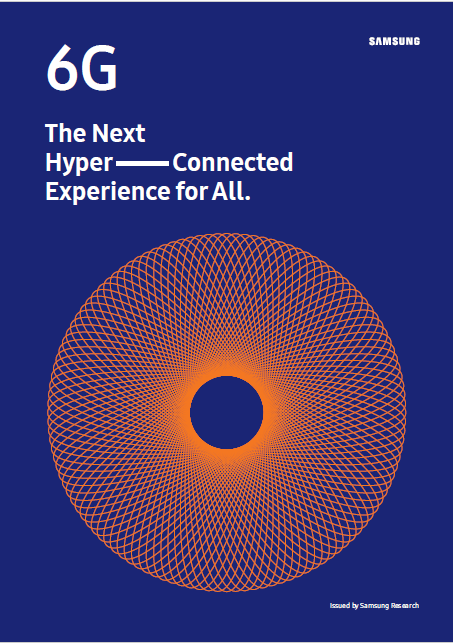
Download PDF here
The notion of “smart cities” unnerves a lot of people, and for good reason. A smart city has cameras around every corner and digital sensors embedded in pretty much everything, from your car to your sink faucet.
This interconnected network—linked through the ghoulish Internet of Things—requires massive data flow from device to device. 5G networks are needed to glue any digital termite colony together. Even now, across Asia and elsewhere, plans are being laid for the 6G revolution.
In this Samsung white paper, we witness milestones in the life of a blonde South Korean digital native—from primitive 4G to modern 5G to ultra-smart 6G.
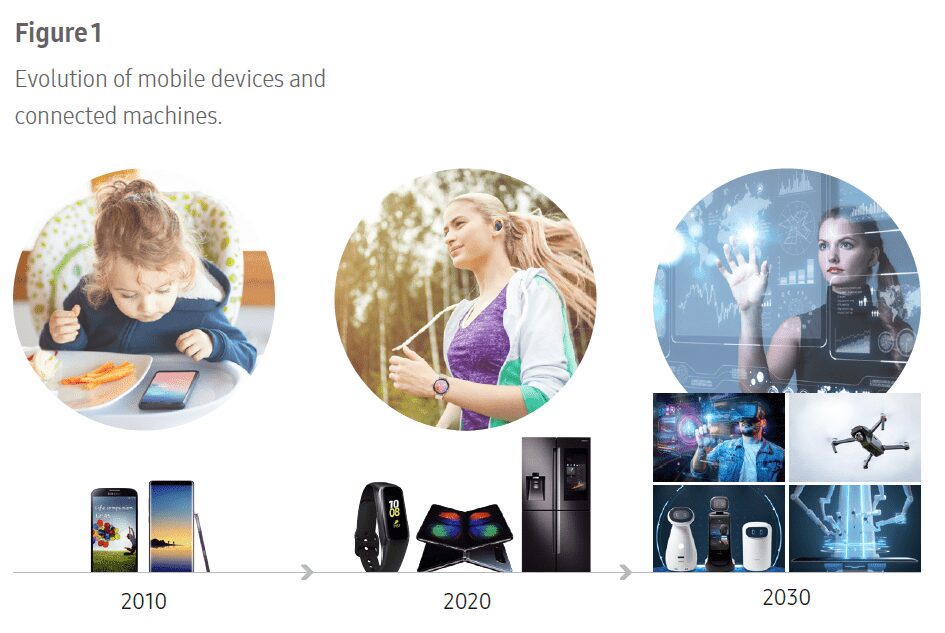
As a wee babe in 2010, she became dependent on her glowing smartphone.
By 2020, she’s an independent woman whose physical being is monitored by wearable devices. Through earbuds, her consciousness is tuned by sensory augmentation. Even her fridge is smart enough to keep tabs on her. Nothing is private, nothing is sacred, but everything—down to her pretty little toes—is smart.
By 2030, her whole consciousness will be shaped by 6G-powered augmented reality. Indoors, bug-eyed robots will ogle her from her nightstand. Outside, drones will watch her from the sky. Over time, she’ll effectively fuse with The Machine. She won’t just be smart—she’ll be super 6G smart.
But it’ll take a sprawling 6G wireless infrastructure to build her humming smart city and cozy smart home:
[T]oday’s exponential growth of advanced technologies such as artificial intelligence (AI), robotics, and automation will usher in unprecedented paradigm shifts in the wireless communication.
These circumstances lead to four major megatrends advancing toward 6G: connected machines, use of AI for the wireless communication, openness of mobile communications, and increased contribution for achieving social goals.
Part of this “connectedness” and “openness” is having every element of your life recorded and replicated in virtual space. Using that information, corporations and governments can construct a virtual model of your entire being, inside and out. They can anticipate your wants and behaviors, and provide just the right stimulus to keep you in line.
On a broad scale, they can do the same with every person, device, robot, and squirrel within reach of their sensors. These “digital twins” can then be studied and manipulated in virtual space—soul clones to be played with like dolls:
Digital Replica
With the help of advanced sensors, AI, and communication technologies, it will be possible to replicate physical entities, including people, devices, objects, systems, and even places, in a virtual world. This digital replica of a physical entity is called a digital twin. In a 6G environment, through digital twins, users will be able to explore and monitor the reality in a virtual world, without temporal or spatial constraints. Users will be able to observe changes or detect problems remotely through the representation offered by digital twins.
In order to realize advanced multimedia services such as truly immersive XR, mobile hologram, and digital replica, 6G needs to provide a much higher data rate than 5G.
Come the revolution, augmented humans will live in a technocratic paradise. We’ll be like wingless eusocial angels, crawling around our 6G-powered termite mound.
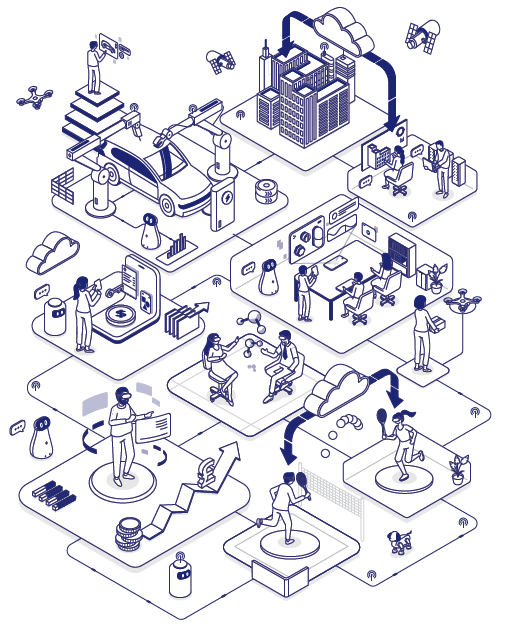
5 – CSET — Mapping U.S. Multinationals’ Global AI R&D Activity (2020)
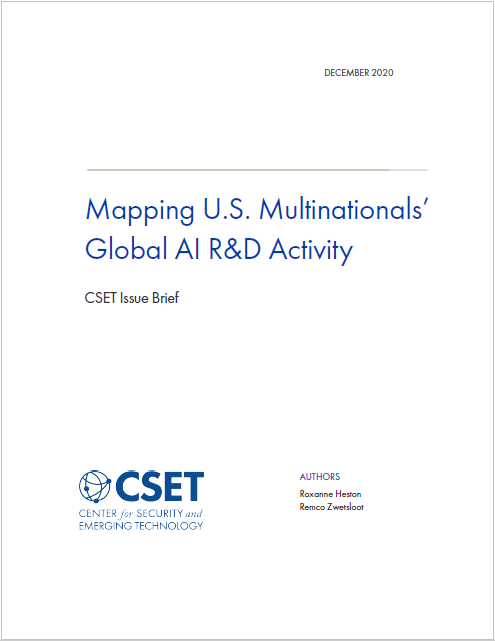
Download PDF here
Artificial general intelligence is the holy grail for transhumanists. The human brain is limited, and there’s only so many smart drugs and iTrodes you can cram in your head. To get past that cognitive limit, it’s believed, we’ll need vast AI systems to do the hard thinking for us.
In fact, nearly every paper in this collection notes that human augmentation is the bridge between the feeble human brain and advanced AI.
But who’s developing these AI systems?
And where?
Mapping U.S. Multinationals’ Global AI R&D Activity tracks six Big Tech firms across the world. Interestingly, most of the experimental work is done overseas. From the executive summary:
• For the four companies where we could find information on labs—Facebook, Google, IBM, and Microsoft—we found 62 labs conducting AI R&D. The majority of these labs (68 percent) were located outside of the United States.
• European countries, mainly the United Kingdom and France, host 19 percent of AI labs in our dataset. Other common destinations were Israel and China (10 percent each) and India (8 percent). The only region in the world without any AI labs was Latin America.
• Media reports and economic studies suggest U.S. immigration restrictions are associated with U.S. companies’ global expansion.
• Many of the world’s biggest AI companies are American; this paper focuses on Amazon, Apple, Facebook, Google, IBM, and Microsoft in particular. Together, these companies spend over $76 billion on R&D annually, and their collective market capitalization stands above $5 trillion.
• Their business models are globalized. Apple, Facebook, Google, and IBM each receive less than half of their total revenue from the U.S. market. Microsoft and Amazon receive 51 percent and 69 percent, respectively.
This international market, along with a pliable foreign labor force, provides an explanation for why Silicon Valley and Seattle are so keen on open borders. To Big Tech, the world is one big pile of data (and dollars) waiting to be sucked up into The Machine.
According to this report, the “number of public AI labs by company” is:
- Google: 23
- Microsoft: 20
- IBM: 11
- Facebook: 8
After seeing the meteoric rise of Google’s DeepMind project—based in the UK—it’s no surprise they dominate the field. Microsoft is coming up behind them fast, though, and IBM’s Watson is legendary.
While most personnel are based in the U.S. (68%), most of the actual labs are operated overseas (also 68%). Why? Cheap labor, obviously. But one wonders if AI companies aren’t also attracted by lax ethical constraints. The paper doesn’t say.
As if their seeds were scattered by the four winds, American AI labs have sprouted up across the globe. Many are unaware of this, but Nigeria is a hot spot for computer programmers.
However, for unstated reasons, American AI firms abhor Latin America. Maybe their bots don’t like llamas and piranhas.
On the other hand, an alarming number of American AI labs currently operate in China. Google and IBM both have a lab there. Of Microsoft’s twenty labs, four are in China. If you ever wondered how communists came up the ingenious TikTok algorithms to ensare the ‘Merican mind, wonder no more. Pandas learn fast.
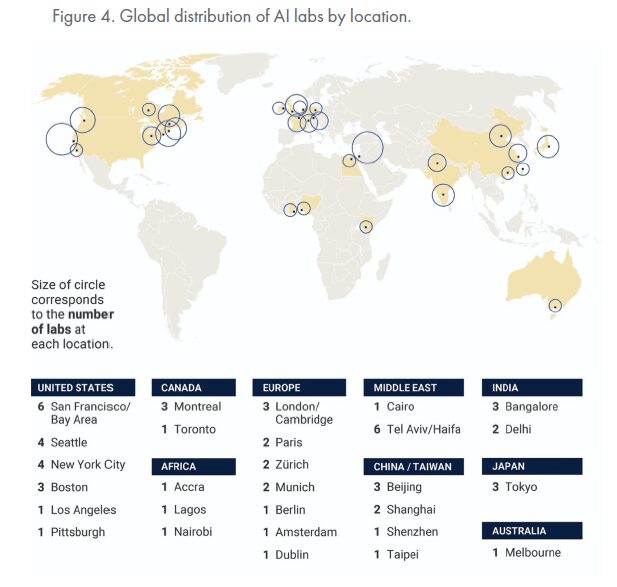
Coincidentally, in the 2019 Netflix documentary Inside Bill’s Brain: Decoding Bill Gates, the last episode centers on Gates’s experimental nuclear power plants in China. The series ends with Gates bummed out that Trump’s aggressive policies threw a monkey wrench into his China projects.
Was there an impact on Microsoft’s experimental AI research, too? How about now, under Biden? These days, Elon Musk is doing great over there.
Chinese collusion aside, the four “American” corporations tracked above have AI headquarters all over the world:
- Facebook AI Research (FAIR) (Menlo Park, CA | New York, NY | Paris, France | Tel Aviv, Israel | London, UK)
- Google – DeepMind Lab (London, UK)
- IBM Research (Dublin, Ireland)
- Microsoft Research Lab – AI (Redmond, WA, USA)
The top AI labs in the East are:
- Baidu Research (Beijing, China | Silicon Valley, CA, USA)
- Tencent AI Lab (Shenzhen, China)
- Brain AI Lab (Daegu, South Korea)
- ElkanIO Research Labs (Kerala, India)
The top AI labs in the US:
- MIT Computer Science and Artificial Intelligence Laboratory (Boston, USA)
- J.P. Morgan AI Research Lab (New York, NY, USA)
- UTCS AI-Lab – University of Texas (Austin, TX, USA)
- Berkeley AI Research Lab (Berkeley, CA, USA)
- Stanford AI Lab (Stanford, CA, USA)
- USC Information Sciences Institute (Marina del Rey, CA, USA)
The top AI labs in Canada:
- Laboratory of Imaging, Vision and Artificial Intelligence (LIVIA) (Montreal, Canada)
- AltaML (Calgary, Canada)
The top AI labs in Europe:
- The Alan Turing Institute (London, UK)
- Oxford Machine Learning Research Group (Oxford, UK)
- King’s College London (London, UK)
- Fraunhofer Heinrich Hertz Institute (Berlin, Germany)
And don’t forget the international operations of Ben “Squirrel-Herder” Goertzel and David “Robo-Lover” Hanson:
- SingularityNET (Amsterdam, Netherlands)
- Hanson Robotics (Hong Kong, China)
Which corporation will stamp its trademark on the fabled Super Computer God?
And who will patent the iTrode that allows mortals to speak with this digital deity?
Download PDF here
6 – RAND Corp. — The Internet of Bodies (2020)
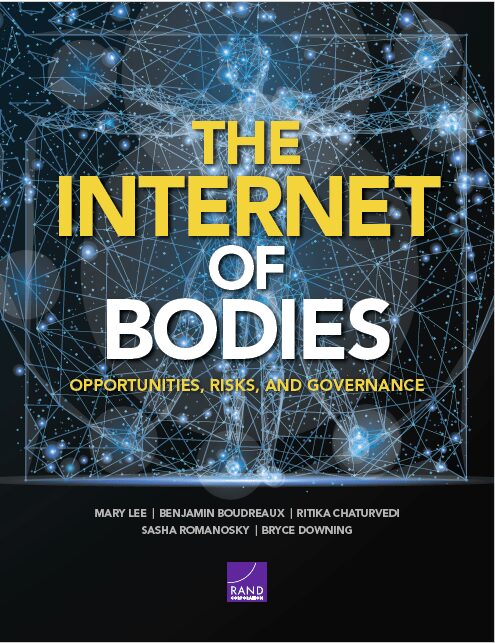
The RAND Corporation is a non-profit think tank funded by both the US government and private donors. Their specialty is serving up policy papers for the US Armed Forces. Here, we read about the future of bio-horror, aka the Internet of Bodies:
A wide variety of internet-connected “smart” devices now promise consumers and businesses improved performance, convenience, efficiency, and fun. Within this broader Internet of Things (IoT) lies a growing industry of devices that monitor the human body, collect health and other personal information, and transmit that data over the internet. We refer to these emerging technologies and the data they collect as the Internet of Bodies (IoB).
To my surprise, this paper actually mentions the direct connection of IoB tech to transhumanism (pg. 5):
Transhumanism is a worldview and political movement advocating for the transcendence of humanity beyond current human capabilities. Transhumanists want to use technology, such as artificial organs and other techniques, to halt aging and achieve “radical life extension.”
Taken together, the already existent human-machine hybrids below are laying the foundation of cyborg culture.
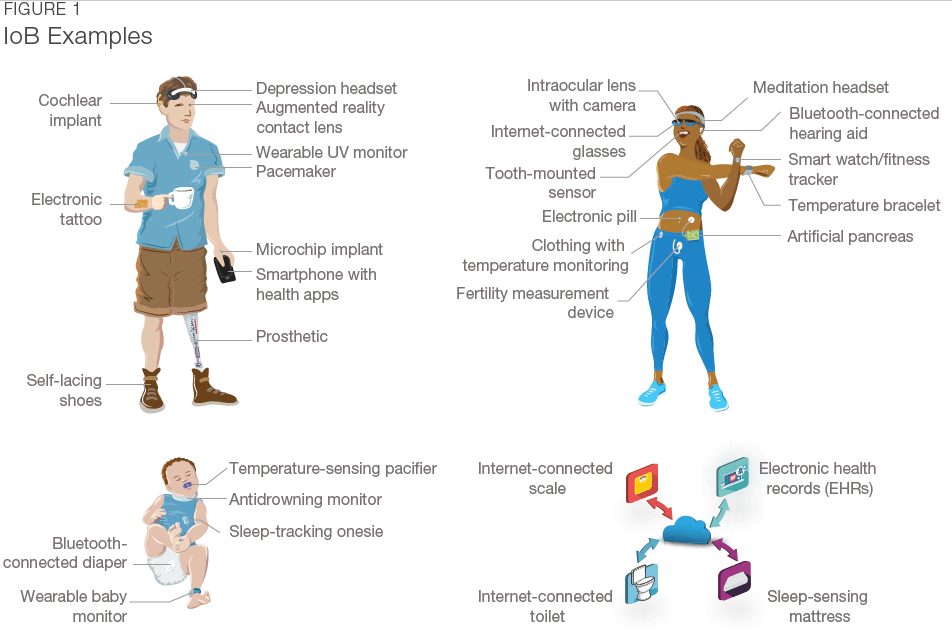
Under a biosecurity state, the normalization of these devices will only accelerate:
By 2025, there will be more than 41 billion active IoT devices, generating 2.5 quintillion bytes of data daily on environment, transportation, geolocation, diet, exercise, biometrics, social interactions, and everyday human lives.
This explosion in IoT devices will result in further popularity of IoB devices.
To their credit, the RAND Corp. authors voice serious concern about the potential dangers of these technologies.
Connectivity of internet-connected devices is evolving in kind and quality and will be further enabled by communication technologies, such as 5G, next-generation Wi-Fi, and satellite internet. But communication systems are likely to be targeted by adversary nations and criminal hackers.
They also confront possible dystopias wherein governments, corporations, insurance agencies, and/or employers monitor your every burp and bowel movement to use that information against you.
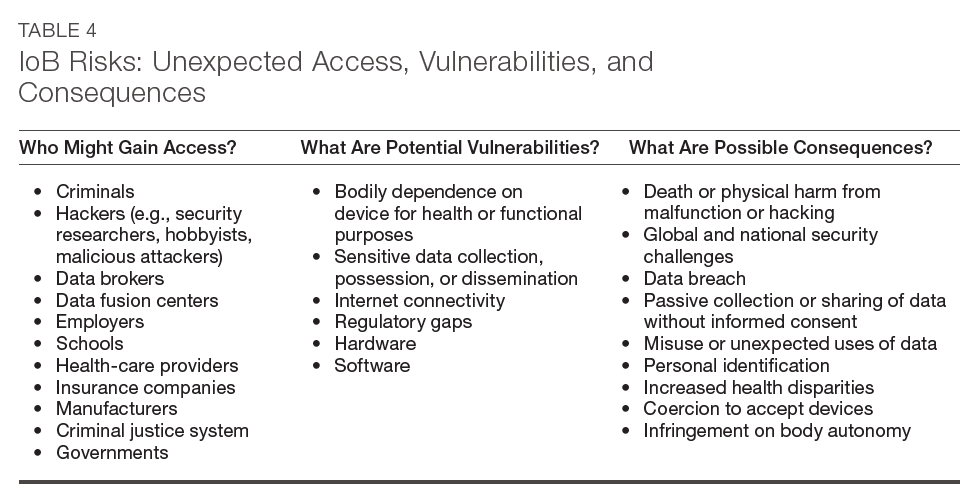
As with every technology, the specter of the CCP looms over the Internet of Bodies—both through competition and collusion:
China is also pursuing a long-term strategy to become a biotechnology leader and is rapidly advancing in the field through bidirectional investment with U.S. firms, research partnerships with American institutions, and recruitment of foreign- and Chinese-born scientists who have been trained in the United States.
This strategy may enable China to increase its foothold in accessing Americans’ biometric data, at the level of both individual persons and subpopulations, whether by commercial means or espionage.
So the beast-chip in your hand and iTrode in your head might be monitored by Chinese communists. Sounds promising.
Not that the RAND Corporation would ever want halt progress. We can’t have that. Progress is “inevitable.” Having identified the downsides, the authors simply call for more government oversight and regulation.
Seriously, if you can’t trust your own government to keep you safe, who can you trust?
Download PDF here
7 – RAND Corp. — Brain-Computer Interfaces (2020)

Power corrupts. The wires woven into your brain corrupt absolutely. If those don’t corrupt you, the resulting brain infection will.
Repeating a conspicuous pattern, the RAND Corporation can barely contain their excitement about brain-computer interfaces. The dream of hooking the embodied soul directly into a god-machine is too tempting to resist:
The 86 billion neurons of the human brain represent humankind’s primary evolutionary advantage and, perhaps, an area of untapped potential. … What will happen when human brains are freed of their corporeal confines and can control machines directly? …
The technical means for this brain-body bypass are BCIs, defined as methods and systems for providing a direct communication pathway between an enhanced or wired brain and an external device, with bidirectional information flow (between the brain and a device).
We’re talkin’ about using thoughts to control drone swarms, machine-gun turrets, and robotic dogs.
We’re talkin’ about WiFi-enabled telepathy:
A natural extension from research that aims to read brain signals, and to send or implant information in the brain, is brain-to-brain communication.
At the next level, we’re talkin’ about true communion with artificial intelligence. Before long, we’ll talk about it using nothing but the iTrodes in our brains:
Data (or information) from a human brain can be used not only to inform assessment tools or to drive systems but also to inform software with cortically coupled AI. … This information can then potentially help train an AI system. …
This use of BCI represents a heightened level of human-machine teaming, allowing a human to think with a machine (or a computer) or, more specifically, integrate human thoughts or data into a process conducted by machine. … Such teaming is of particular interest to members of the AI community who are exploring methods and approaches for managing and “controlling” AI.
BCI may be able to provide this tool. Elon Musk, the founder of Neuralink, a relatively new company focused on integrating humans with AI, suggests, “Some high bandwidth interface to the brain will be something that helps achieve a symbiosis between human and machine intelligence and maybe solves the control problem and the usefulness problem.”
We’re talkin’ about humans merging their minds with what Musk calls “the demon”—using tax-payer money:
The DARPA Neural Engineering System Design (NESD) program is developing invasive systems that can communicate clearly and individually with any of up to one million neurons in a given region of the brain, and this includes the ability both to transmit to the brain and read from the brain with some neurons.
While current invasive devices may incorporate something on the order of 100 channels, this project strives to read 106 neurons, write to neurons, and interact with 103 neurons full-duplex, a far greater scale than is possible with existing neurotechnology.
Another DARPA program, the Next-Generation Nonsurgical Neurotechnology (N3) program involves a noninvasive system capable of reading from and writing to multiple points in the brain at once.
We’re talking about trans super soldiers using cyber-psychokinesis to rain hell down upon the earth. Naturally, the top brass are stoked.
In the Age of AI, a meager meat-head is lunch for the dogs of war:
Regarding the potential application of BCI, the future warfighter is likely to have increased requirements to:
• digest and synthesize large amounts of data from an extensive network of humans and machines
• make decisions more rapidly due to advances in AI, enhanced connectivity, and autonomous weaponry
• oversee a greater number and types of robotics, including swarms.
The solution? Jam a trode into their cerebral cortex. Victory will go to Humanity 2.0.
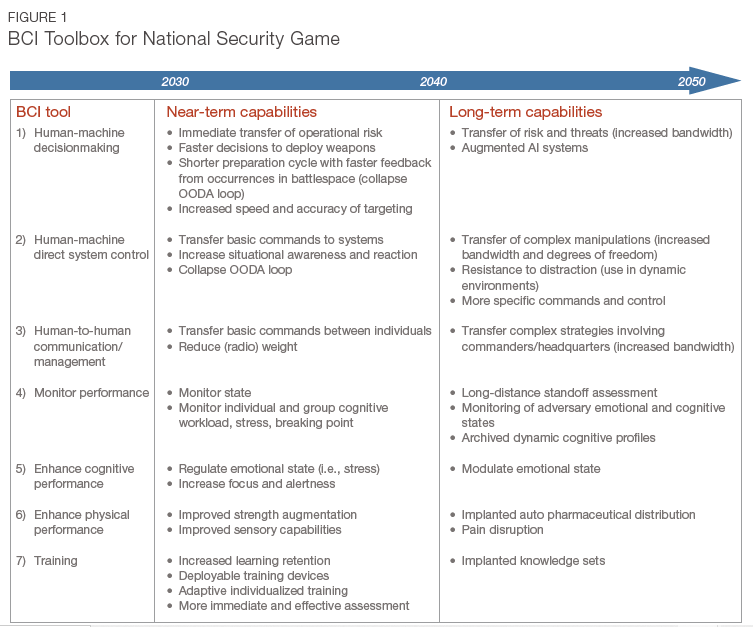
There’s only one roadblock to this “inevitable” progress. No one in their right mind wants a trode in their head:
[W]e recommend that DoD [US Department of Defense] address the trust deficit.
[C]ultural barriers to BCI, particularly among infantry service members, are likely to be high. Trust barriers could be mitigated through heavy vetting and testing in noncombat scenarios…and an initial focus on noninvasive measures and medical applications. …
Acceptance of BCI may also be complicated by a general phenomenon referred to in the bioethics community as the “yuck factor,” in which a negative emotional response is provoked by new advances in biotechnology. Lack of trust would likely be more acute for invasive BCI, which requires alterations to the human body and poses health risks, such as infection.
Trust could also be influenced by the scope of the information accessed by BCI technologies. Service members may not want to provide the U.S. government, or its machines, with access to the inner workings of their minds.
I mean, if you can’t trust your own military-industrial complex, who can you trust?
Download PDF here
8 – NATO — Cognitive Warfare (2020)

h/t Ben Norton @BenjaminNorton
Certain technologies can twist your noodle so it never unravels. Mass-produced propaganda, repetitive recordings, TV hypnosis, social media manipulation, smartphone dependency, BCI helmets, implanted electrodes, neuron-targeting nanoparticles—these mindwarps can completely reshape your reality.
Think about the big picture. If you can warp one person’s reality, you can warp the entire public consciousness:
In its broadest sense, cognitive warfare is not limited to the military or institutional world. Since the early 1990s, this capability has tended to be applied to the political, economic, cultural, and societal fields. Any user of modern information technologies is a potential target. It targets the whole of a nation’s human capital.
Cognitive Warfare is part of an in-depth series, commissioned by NATO, to study the dangers and opportunities of turning a person’s brain into mush. (The entire collection can be found HERE. Be sure to check out Cognitive Biotechnology. It’s excellent.)
The basic premise of Cognitive Warfare is that our evolved mental biases are a key pressure point for national security threats. The most intense focus is on confirmation bias—our tendency to readily accept information that confirms prior beliefs.
Believe it or not, that’s how your mind works.
(As much as I despise Wikipedia, they host a decent list of cognitive biases, diagrammed below.)
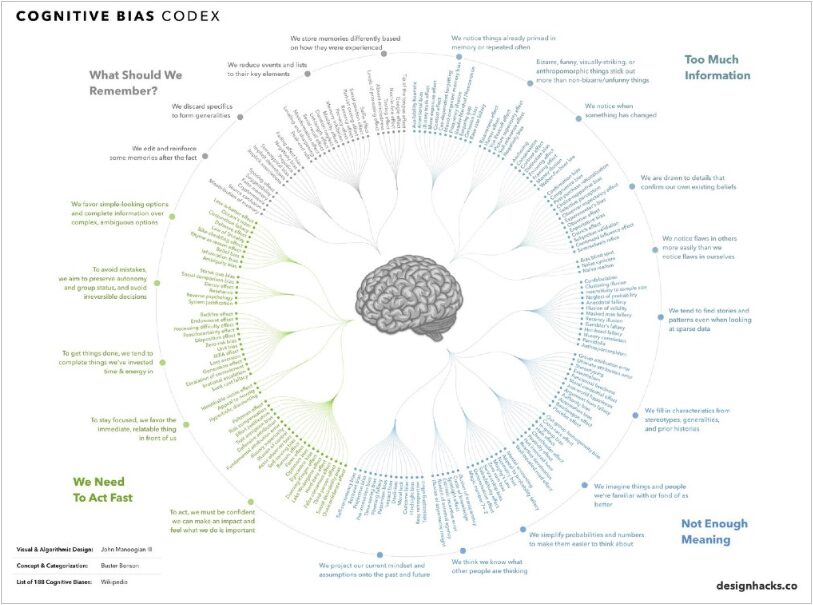
Because these cognitive biases can be easily exploited, the human psyche is inherently vulnerable:
In particular, the brain:
• is unable to distinct whether particular information is right or wrong;
• is led to take shortcuts in determining the trustworthiness of messages in case of information overload;
• is led to believe statements or messages that its already heard as true, even though these may be false;
• accepts statements as true, if backed by evidence, with no regards to the authenticity of the that evidence.
The paper covers many psy-op tactics, but among the most devastating is trust subversion. Because our minds are easily manipulated—and because we’re convinced of our own powers of discernment—it’s fairly easy to shatter public trust. The paper warns that this is an immanent danger to Western nations. If an enemy wants to destabilize a society, “trust is the target”:
Cognitive Warfare is a war of ideologies that strives to erode the trust that underpins every society. … The use of fake news, deep fakes, Trojan horses, and digital avatars will create new suspicions which anyone can exploit. …
Cognitive warfare pursues the objective of undermining trust (public trust in electoral processes, trust in institutions, allies, politicians…), therefore the individual becomes the weapon, while the goal is not to attack what individuals think but rather the way they think. It has the potential to unravel the entire social contract that underpins societies.
As our cultural fabric is ripped apart by radical feminism, televangelism, racial strife, psychedelics, tech-addiction, transnationalism, transgenderism, and soft transhumanism, you have to wonder how many of our day-to-day conflicts are the result of cognitive warfare—whether civil or international:
It feeds on the techniques of disinformation and propaganda aimed at psychologically exhausting the receptors of information. … Whatever the nature and object of warfare, it always comes down to a clash of human wills, and therefore what defines victory will be the ability to impose a desired behaviour on a chosen audience.
Once a military strategist has wrapped his or her (or maybe even their) head around a society’s way of thinking—perhaps through spyware on social media apps—any brain can be molded like so much electric clay:
Social engineering always starts with a deep dive into the human environment of the target. The goal is to understand the psychology of the targeted people. This phase is more important than any other as it allows not only the precise targeting of the right people but also to anticipate reactions, and to develop empathy.
This empathic awareness, devoid of sympathy, is the psychopath’s greatest tool. Once you’ve gotten into someone’s head—typically through privacy invasion—you can break them inside out:
Understanding the human environment is the key to building the trust that will ultimately lead to the desired results. Humans are an easy target since they all contribute by providing information on themselves, making the adversaries’ sock-puppets more powerful. …
It is easier and cheaper for adversaries to undermine trust in our own systems than to attack our power grids, factories, or military compounds.
Of all the sinister bits in this document, and there are plenty, one passage about the pandemic really stood out. To their credit, the authors suggest that dismissing useful medicines as “fish tank cleaner” rattled the public trust:
As the example of COVID-19 shows, the massive amount of texts on the subject, including deliberately biased texts (example is the Lancet study on chloroquine) created an information and knowledge overload which, in turn, generates both a loss of credibility and a need for closure.
Surveying the chaos and confusion in Western nations, a paranoiac might conclude we’re being pummeled by cognitive bombs harder than we’ve been hit with this leaked bioweapon.
Speaking of China, the authors sound the alarm on the CCP’s rapidly advancing psycho-technology:
As part of its Cognitive Domain of Operations, China has defined “Military Brain Science (MBS)” as a cutting-edge innovative science that uses potential military application as the guidance…creating a whole new “brain war” combat style and redefining the battlefield.
The only proper response, of course, is to beat the Chinese technocrats at their own game:
Failing to thwart the cognitive efforts of NATO’s opponents would condemn Western liberal societies to lose the next war without a fight.
It’s reassuring that we have our top men on this. But as I contemplate the authoritarian response to the US Capitol riots and the worldwide anti-vaxx protests, and yes, those incidents when cops cracked down on BLM rioters—events hopelessly distorted by media lies—there’s one small concern left to address.
The greatest danger may not be a foreign adversary waging cognitive warfare on us, but rather our own governments—under control of corporate and financial elites—using every device at their disposal to zap us into submission.
Download PDF here
9 – The Royal Society — iHuman (2019)
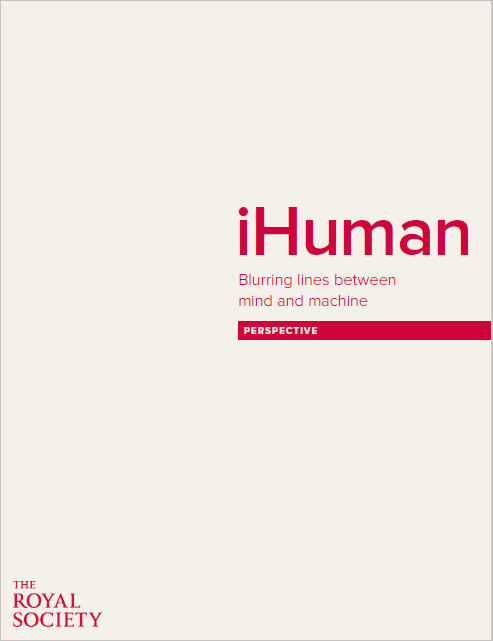
Download PDF here
Humans are a tool-making, tool-using species by nature. This leads transhumanists to ask, quite reasonably, if there’s an essential difference between a spear-throwing caveman and a jacked-in cyborg controlling a drone swarm with her brain.
In iHuman: Blurring the lines between mind and machine, Royal Society scholars note that in ancient Rome, a physician would slap an electric ray on a patient’s dome to treat headaches. The implication is that today’s transcranial magnetic stimulation isn’t really new, so why stop now?
Out of all the documents in this collection, the Royal Society of London shows the most enthusiasm for merging the embodied soul with god-machines:
Linking human brains to computers using the power of artificial intelligence could enable people to merge the decision-making capacity and emotional intelligence of humans with the big data processing power of computers, creating a new and collaborative form of intelligence.
People could become telepathic to some degree, able to converse not only without speaking but without words – through access to each other’s thoughts at a conceptual level. This could enable unprecedented collaboration with colleagues and deeper conversations with friends.
The authors warn about possible dangers and abuses, but overall, their reservations seem obligatory. These are ivory tower brainiacs, and nothing gets the intelligentsia’s mojo rising like the promise of unlimited intelligence:
Efforts to enhance memory, learning, decision-making and attention may also provide new solutions. Today’s basic, cheap headsets are likely to be supplanted by more advanced enhancement technologies, possibly including platforms such as multiple micro-implants. Animal tests have already shown ways to create memories, control motion by human thought or embed learning.
Electromagnetic brainwashing may seem unnatural, you pitiful caveman, but if you think about it real hard—until your head explodes—it’s obviously part of natural human progression.
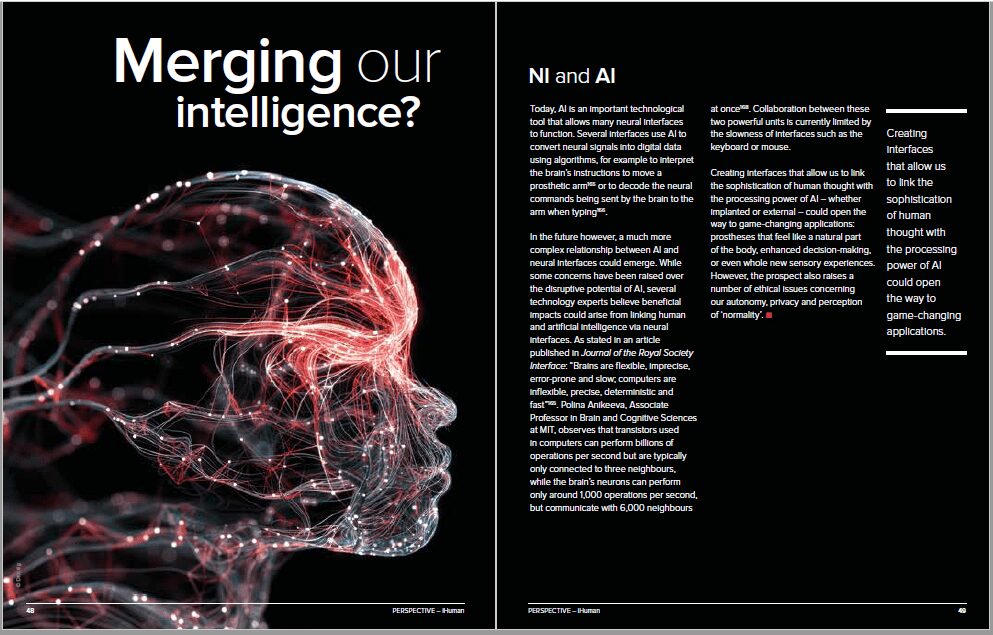
Just as Neanderthals were no match for Homo sapiens, we humans should tremble before the power of The Machine:
“Brains are flexible, imprecise, error-prone and slow; computers are inflexible, precise, deterministic and fast.” …
Creating interfaces that allow us to link the sophisticationof human thought with the processing power of AI could open the way to game-changing applications.
If you can’t beat ‘em, join ‘em.

Back here on Earth, a more practical justification for establishing total technocracy in the West is to keep pace with China:
The ability to read mood from brain signals is already reportedly being used by Chinese companies to monitor employees for signs of anger, anxiety or depression, via devices fitted to safety helmets and caps. According to media reports, companies involved say they are using the data to help workers, but critics say the technology invades privacy.
Those concerns notwithstanding, if the CCP is turning their population into a digitally enhanced superorganism, we should probably do the same:
People who work in hazardous environments could optimize their performance by training in immersive simulations, and in the service sector, people who have caring needs could be empowered to live more independently if they were enabled to command robots using brain signals while having their mood monitored remotely.
So high-steel riggers will train in virtual reality, and caregivers will don electro-helmets to tend to the elderly. No one can accuse the Royal Society of romantacizing the value of a hard day’s work—especially dangerous or dirty jobs. It’s just another problem to be solved by experts.
Which brings us back to the US military-industrial complex:
Interface technology will also inevitably be studied for potential military applications, such as augmenting decision-making, physique, and motivation. … The US’s Defense Advanced Research Projects Agency (DARPA) has set out an aspiration to create a non-invasive neural interface for possibilities such as “immersive training, new forms of interaction with AI systems, improved situational awareness and intelligence analysis, and distributed task management”.
It may seem cruel, but this techno arms race may require turning human beings into radio-controlled super soldiers:
In research, sharks, beetles and pigeons have been implanted with devices that can control their movements. Other technologies could provide personnel with infrared sensing capabilities to detect other people in darkness—or enable their actions to be stimulated by a remote controller.
Whether one fixates on the threat of international rivals or artificial superintelligence, a primary incentive for becoming a cyborg is evolutionary competition. In a shifting landscape, organisms must adapt and overcome.
If your enemies build a superior warship, you’d better do the same. And if your enemies create a Super Computer God and connect their brains to this entity, by God, you’d better do the same.
Whaddaya got to lose?
Download PDF here
10 – Policy Horizons Canada — Exploring Biodigital Convergence (2019)

Download PDF here
In autumn of 2020, Canadian prime minister Justin Trudeau told the UN, “This pandemic has provided an opportunity for a reset. This is our chance to accelerate our pre-pandemic efforts, to reimagine economic systems that actually address global challenges like extreme poverty, inequality, and climate change.”
Those paying attention figured he was referencing the Great Reset. As usual, anyone who didn’t like it was labeled a “conspiracy theorist.” Aside from economic systems, what other “pre-pandemic efforts” was the transracial prime minister “reimagining” for us?
Well, if Trudeau was keeping up with his policy advisors, we can gather some clues from a 2019 Policy Horizons Canada analysis entitled Exploring Biodigital Convergence: What happens when biology and digital technology merge?
Diving headlong off the deep end, the paper “reimagines” the very essence of Nature:
Digital technology can be embedded in organisms, and biological components can exist as parts of digital technologies. The physical meshing, manipulating, and merging of the biological and digital are creating new hybrid forms of life and technology, each functioning in the tangible world, often with heightened capabilities.
Robots with biological brains and biological bodies with digital brains already exist, as do human-computer and brain-machine interfaces. The medical use of digital devices in humans, as well as digitally manipulated insects such as drone dragonflies and surveillance locusts, are examples of digital technology being combined with biological entities.
By tapping into the nervous system and manipulating neurons, tech can be added to an organism to alter its function and purpose. New human bodies and new senses of identity could arise as the convergence continues.
Browsing the document’s sleek images, it’s clear the woman who edited it had an eye for graphic design. The diagrams are pretty tidy, too.
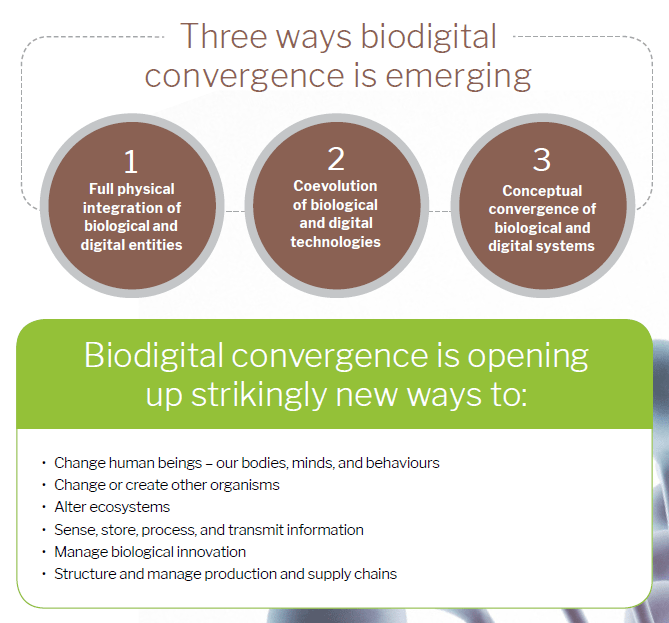
The above parameters—integration, coevolution, and convergence—cover the fusion of living things with machines, the relational development of living things and machines, and an emerging mindset that views living things as mechanical and machines as alive.
What are these wild-eyed government hacks talking about specifically? Examples include:
• Altering the human genome – our core biological attributes and characteristics
• Monitoring, altering, and manipulating human thoughts and behaviours
• Brain-machine interfaces that enable machines to be controlled through brain signals
• Prosthetics that use machine-learning algorithms to expand functionality and sensitivity
And on and on, until we arrive at Humanity 2.0. As scientists tinker around with the wider world, we’ll find ourselves at the gates of Eden 2.0:
• Creating entirely new organisms with tailored characteristics
• Changing and eradicating entire species [such as malaria-spreading mosquitoes]
• Geoengineering approaches that accurately model carbon capture or solar reflectance
• Turning organisms into biocomputers
And so on.
All of this is total madness. It’s also just over the horizon and bearing down on us fast. Meticulous citations link each of the above “capabilities” to successful projects, as seen below.
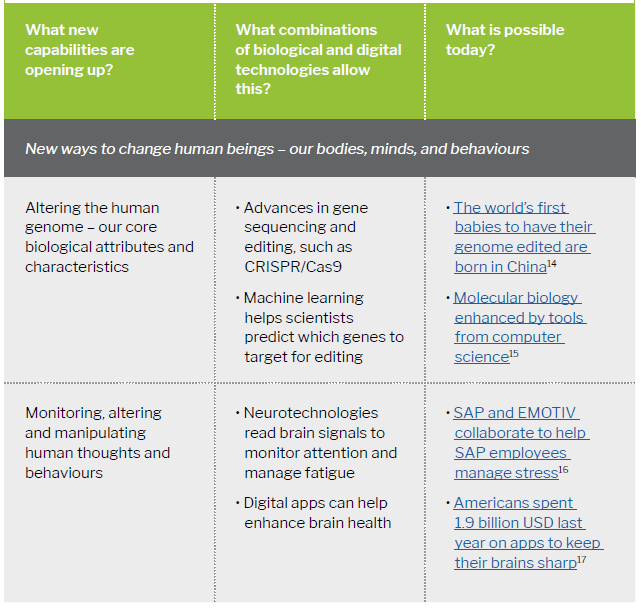
This isn’t science fiction. This is happening right now.
The authors signal their concern with the usual hand-wringing about negative outcomes, but in general, their tone brims with the optimism one needs to play God:
Based on initial signals, the characteristics of the biodigital system could include:
• democratization
• decentralization
• geographic diffusion
• scalability
• customization
• reliance on data
Sounds groovy, I suppose. But if you’re familiar with buzzwords like “equity” or “justice”—which mean stamping on undesirables in favor of useful idiots, or unleashing furious mobs to burn city centers to the ground, respectively—you might suspect that “reliance on data” and “democratization” will amount to mass surveillance and manufacturing consent.
Don’t think the authors haven’t considered that problem:
What policies could foster trust among partners and stakeholders?
Biodigital convergence relies on a wide array of biological data, which may change the way citizens relate to businesses that provide services. The relationship between firms and individuals may require higher levels of trust, as firms seek access to highly intimate data about our lives and bodies.
For example, human “digital twins” could become valuable assets beyond healthcare. Social services, the justice system, environmental services, and education providers may all need to be trusted with, manage, and act on increasingly intimate data that relate to people and the world around them.
If you can’t trust your corporate technocrats with “highly intimate data,” who can you trust?
Download PDF here
1 – UK Ministry of Defense — Human Augmentation (2021)
2 – IBM — Privacy and the Connected Mind (2021)
3 – XRA — Immersive Technology and Infrastructure (2021)
4 – Samsung — 6G: The Next Hyper-Connected Experience for All (2020)
5 – CSET — Mapping U.S. Multinationals’ Global AI R&D Activity (2020)
6 – RAND Corp. — The Internet of Bodies (2020)
7 – RAND Corp. — Brain-Computer Interfaces (2020)
8 – NATO — Cognitive Warfare (2020)
9 – The Royal Society — iHuman (2019)
10 – Policy Horizons Canada — Exploring Biodigital Convergence (2019)
It’s tempting to read these white papers as sinister manifestos.
Don’t kill the messenger.
If these organizations hadn’t published their reports, cyborg tech would race forward while the public remained in the dark. Because these realities are out in the open, we have a chance to divert this insane race to dehumanization.
Choose wisely.
Further Reading
- Why “Transhumanism” is the Issue of Our Age — Singularity Weekly | December 14, 2021
- Reaching for the Mark of the Beast — Singularity Weekly | September 15, 2021
- Swedes Are Implanting Microchip Vaccine Passports. It Won’t Stop There — The Federalist | December 23, 2021
- Chipped Hands, Chipped Heads – The Dark Future of Bio-Implants — Salvo | December 16, 2021
- Artificial Intelligence is an “Alien Mind” Transforming The Human Race — Salvo | December 1, 2021
- Transhumanists Gather In Spain To Plan Global Transformation — The Federalist | October 15, 2021

